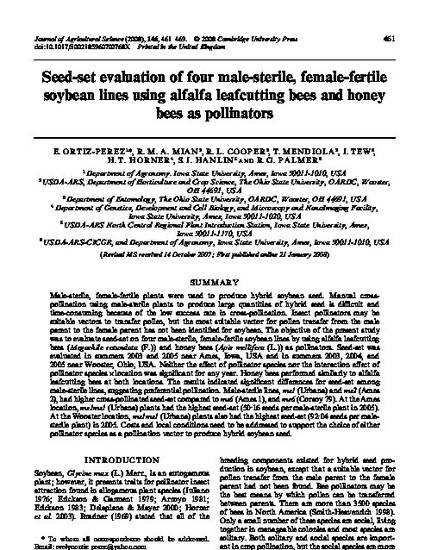
Male-sterile, female-fertile plants were used to produce hybrid soybean seed. Manual cross-pollination using male-sterile plants to produce large quantities of hybrid seed is difficult and time-consuming because of the low success rate in cross-pollination. Insect pollinators may be suitable vectors to transfer pollen, but the most suitable vector for pollen transfer from the male parent to the female parent has not been identified for soybean. The objective of the present study was to evaluate seed-set on four male-sterile, female-fertile soybean lines by using alfalfa leafcutting bees (Megachile rotundata (F.)) and honey bees (Apis mellifera (L.)) as pollinators. Seed-set was evaluated in summers 2003 and 2005 near Ames, Iowa, USA and in summers 2003, 2004, and 2005 near Wooster, Ohio, USA. Neither the effect of pollinator species nor the interaction effect of pollinator species×location was significant for any year. Honey bees performed similarly to alfalfa leafcutting bees at both locations. The results indicated significant differences for seed-set among male-sterile lines, suggesting preferential pollination. Male-sterile lines, ms1(Urbana) and ms2 (Ames 2), had higher cross-pollinated seed-set compared to ms6 (Ames 1), and ms6 (Corsoy 79). At the Ames location, ms1ms1 (Urbana) plants had the highest seed-set (50·16 seeds per male-sterile plant in 2005). At the Wooster location, ms1ms1 (Urbana) plants also had the highest seed-set (92·04 seeds per male-sterile plant) in 2005. Costs and local conditions need to be addressed to support the choice of either pollinator species as a pollination vector to produce hybrid soybean seed.
Available at: http://works.bepress.com/harry-horner/90/

This article is from Journal of Agricultural Science 146 (2008); 461, doi: 10.1017/S002185960700768X.